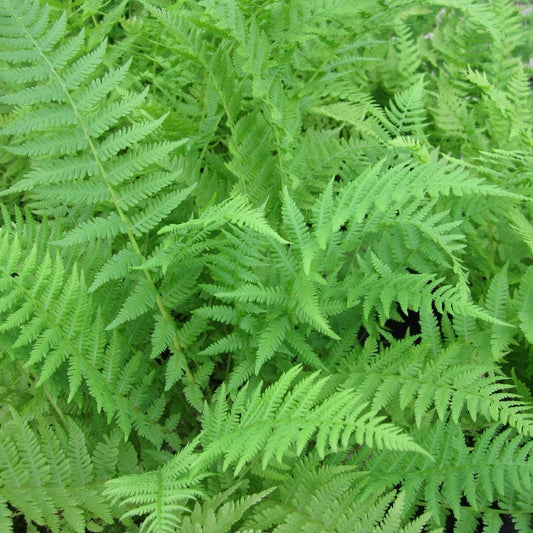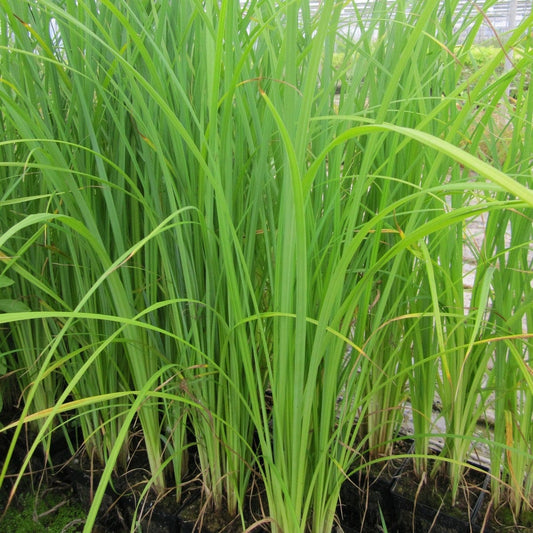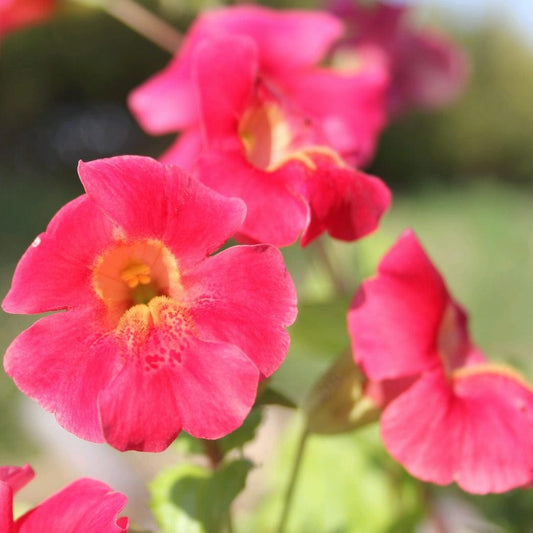Planting Pond Plants: A Beginner’s Guide

Adding a pond to your garden is becoming increasingly popular. It provides a valuable natural habitat for all kinds of creatures including frogs, newts, fish and dragonflies; as well as giving you the calming effects of water and the joy of wildlife watching. One of the main factors that put people off, however, is uncertainty about planting pond plants - mistakes can be expensive and frustrating. We’re often asked questions like How do you get the plants to the bottom of the pond? Do you have to wade in? How do you stop the soil floating away? And what’s an aquatic basket?
We put these and other questions to our expert pond plant growers, and with their help we’ve put together this easy guide to getting started.
Jump to:
- When should I plant?
- Which plants do I need?
- How big will my plants grow?
- How should I arrange them?
- What equipment will I need?
- How to plant marginals
- How to plant oxygenators
- How to plant deep water plants
When should I plant?
Although the best time of year to plant pond plants is mid spring to early summer, when the water is starting to warm up and the plants will establish quickly. You can however plant at any time of year as long as the water isn’t frozen over. Be aware that new plants might be dormant in winter and may not look too impressive, but they’ll soon make up for it when the weather warms up!
Which plants do I need?
You’ll need a good mix of marginal, oxygenating and floating plants for a well balanced pond. You might also consider adding pondside or bog plants, which live not in the pond itself but in the damp soil next to it. If you want your pond to attract wildlife, UK native plants are best. Take a look at the amount of sunlight your pond gets over the course of a day and choose your plants accordingly - if the info on the website says they need full sun, that means 6-8 hours of sunlight each day in spring and summer. That’s great for ponds in the middle of a south facing garden, but if your pond is on the shadier side, you’ll need to choose plants with less demanding light requirements.

How big will my plants grow?
There’s nothing worse than planting your beautiful new plant and watching it grow… and grow too big for the space it’s in. Check on our website to see how tall and wide your plant will eventually become, and be sure to leave enough space in between plants as well as planting them in water that is neither too deep nor too shallow for them (more about this below).
How should I arrange them?
Planting the same type of plants together in a group is best for pollinators - a clump of pollen rich flowers is more tempting than a single plant. You should also consider your sightlines - look at your pond from the position you’ll spend most of your time in (e.g. a patio or deck) and taking that as your starting point, arrange the shorter plants in front of the taller ones so you can see them all properly.

What equipment will I need?
Mesh planting baskets/fabric planters
These are useful for two reasons:
- making sure your plant stays in position and doesn’t float into another area of your pond,
- restricting especially vigorous plants so that they don’t spread everywhere!
Most pond plants will be fine in a 2-3 gallon sized basket, but water lilies need a lot of space and will be happier with a 2-5 gallon basket, depending on their eventual size. You can also opt to plant directly into soil or gravel, using rocks to weight down the base of the plant, if you don’t want to use baskets.
Aquatic soil
Ordinary compost or soil is too light for pond planting - it’ll just float away and muddy the water. Aquatic soil (or planting medium) is heavy enough to retain moisture without breaking up while also anchoring the plants and keeping them upright.
Gravel
Again, this should be purpose-made aquatic gravel. It goes in the planting basket on top of the soil, to provide better anchorage, keep weeds away and also stop fish from digging around the plant.
Weights
You may have wondered how to get plants to the bottom of your pond if the water is deep - if you don’t fancy wading in and getting wet, you can use weights, either in a planting basket or attached to bundles of plants, then dropping or lowering them into the water.
Plant food
Although most pond plants don’t need feeding regularly, it can help new plants - especially water lilies - to establish more quickly if you give them a fertiliser capsule or tablet. These are pushed into the soil around the plant and release their nutrients gradually. If your aquatic soil contains added fertiliser, miss out this step.
Here’s how to plant each type of pond plant
How to plant marginal pond plants
Marginal plants grow around the edges of the pond. Choose your marginal plants according to how tall they grow and the depth of your water. Most will be happy in a depth between 5-15cm, but do check the information on the website or plant label to make sure. The other important measurement to check is how much space to leave between plants. It may look as if you’re leaving big gaps now, but they’ll soon spread!
Planting in a container
Choose a planting basket large enough for your plant to grow and spread, and don’t plant more than three in the same basket. Baskets with larger holes will need lining on all sides with hessian or other permeable fabric to stop the soil coming out, but if your planting basket has fine mesh holes, you won’t need to do this. Remove your plant from the grower’s pot it came in and rinse the roots in some water if they’ve become tangled.
Next, put a layer of large stones at the bottom of the pot to weigh it down in the water and stop the pot from tipping over. Fill the pot half full with aquatic soil and position your plant in the centre before adding more soil to cover the roots completely. Finally, add a 2.5-5cm layer of gravel or more stones at the top to cover the soil completely.
Before planting, soak the pot in a bucket of water for a few minutes - this will help to get rid of any loose gravel or soil and help to weigh it down. Allow the pot to drain, then place the pot under the water in the position you want it. The whole pot should be submerged and the plant above the water. You can add more rocks around the pot to keep it in place if necessary.

Planting directly into the pond
In unlined ponds, you can plant straight into the soil. As above, remove your plant from its grower’s pot and untangle the roots. You have a couple of options when it comes to finding the right position: either plant into the wet soil around the edge of the pond or move some rocks or gravel under the water to make space for your plant to be partially submerged. Again, check your plant’s particular requirements.
When you’ve found the perfect position, lower your marginal plant into the water roots down and place it upright in the water before stacking stones and rocks around it to stop it floating away. The roots will soon work themselves into the soil.
How to plant oxygenators
Oxygenating plants can be divided into floating or submerged plants - each kind has its own method of planting - so your first task is to check which kind you’ve got. They often come as a bunch of plants without a pot, sometimes with a weight already attached.
Floating oxygenators
Floating oxygenators like frogbit and water lettuce are the easiest of all pond plants and don’t need planting at all - just remove them from their packaging, throw them in and let them float on the surface. If you’re doing this in the heat of summer, it’s a good idea to float your plant in a container of cool pond water to rehydrate before putting it straight out in the hot sun, which could burn its leaves.
Submerged oxygenators
Submerged plants live completely underwater and include hornwort and water milfoil - they need to be weighted in order to sink to the bottom of the pond and don’t do well in baskets as they need to move up and down freely according to the changing water temperature. Simply wrap the weight around the base of the bunch and drop it into the pond - that’s all there is to it!

How to plant deep water plants and water lilies
Plants such as water lilies and water hawthorn are planted at the bottom of the deepest water of the pond, then their leaves rise up and float on the surface. They should be planted in full sun with plenty of space around each one and away from waterfalls and water features as they need the top surface of their leaves to be clear in order to breathe.
To plant your water lily (or floating plant), prepare a large basket in the same way as for marginal plants detailed above. Position the lily at a 45 degree angle in the basket and add fertiliser before adding the gravel layer. You might need to place some bricks on the bottom of the pond if your plant isn’t large enough for the leaves to float to the surface. When it grows bigger you can remove the bricks and lower it to its final position on the bottom of the pond.
Lower the basket slowly into the pond at an angle, allowing the air bubbles to escape, until you reach the desired depth. Within a few days, your lily’s leaves should float to the surface.

Last updated: 13/11/2023





















